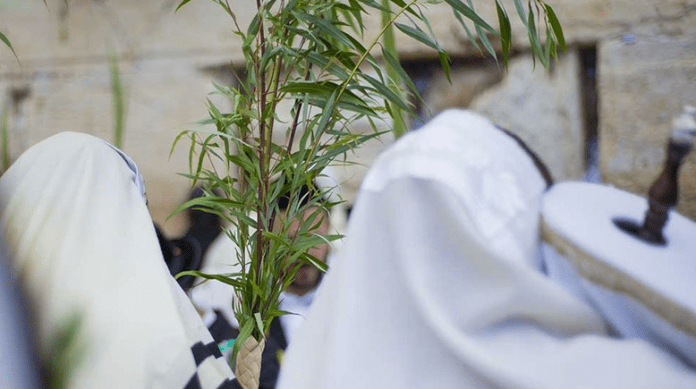What is Hoshana Rabbah?
The meaning of Hoshana Rabbah, literally “the Great Salvation,” comes from hosha = save, na = please, rabba = great. There are three designated days in the calendar for good judgement, Rosh Hashana, Yom Kippur, and Hoshana Rabbah.
Every day of Sukkot we walk around the Torah with our lulav and etrog in hand asking Hashem hosha na – to please bring salvation and goodness throughout the year. On the last day of hol hamo’ed Sukkot, as this is the seventh time that we encircle the Torah and the climax of Sukkot, we ask for salvation and help from Hashem in many ways, especially regarding the crops and rain.
In the times of the Bet Hamikdash, circling the mizbeach with aravot was performed every day, once, and the seventh day seven times. This was so important, that even if it occurred on Shabbat, circling the mizbeach with aravot was still performed.
What do we do special on this day?
1) We study the tikkun throughout the night, reviewing the entire Sefer Devarim and Tehillim with excerpts of selihot 2) after Hallel we recite in the hoshanot, specific prayers for many aspects of agriculture 3) after the Tefillah we take five aravot and bang them against the dirt.
What is the meaning of the extra hoshanot prayers?
We go around the Torah seven times with our lulav and etrog asking “hosha na” – please help – while mentioning Selihot that upon each segment highlight the merit of one of the seven ushpizin, the first one corresponding to Avraham, the second to Yishak, etc.
After the seventh circuit we then build upon the refrain of hosha na to more and more steps of beseeching, totaling ten steps.
- Hosha na – We open with the core prayer that we have recited all of the preceding days of Sukkot, asking Hashem to save us.
- Anna hoshiah na – We ask for the rebuilding of the Bet Hamikdash
- Ani VaHu hoshiah na – We ask for salvation from oppression with the merit of the four species that correspond to parts of our body etrog = heart, lulav = spine, hadasim = eyes, aravot = lips.
- Anna El na Hosha-na v’hoshia na – We ask for Him to open the bounty of produce, (naming wheat, barley, spelt, oats, rye, rice, millet, beans, lentils, olive trees and olive oil, grapes, figs, pomegranates, walnuts, dates, apples, pistachios, almonds, chestnuts, carob, mini fruit, peaches, berries, pears, etrog, and all types of vegetables and grains).
- Anna El na hosha na v’hatsliha na – We ask to be transplanted back in Eretz Yisrael with its full blessings of bounty and water.
- Anna El na hosha na v’harviha na Avinu attah – We ask Hashem to not withhold blessed rainwater, and we invoke here the merit of Noah, Avraham, Yishak, Yaakov, and Moshe Rabbenu, who found favor in the Eyes of Hashem.
- Anna El na refa na, selah na, hashana v’hoshia na, Avinu attah – We invoke the merit of Noah, Avraham, Yishak, Yaakov, Moshe, and Aharon that our prayers today be of glory, praise, cherished, etc. to carry throughout the year.
- Hoshienu Moshi’enu ki lecha enenu u’lecha lishuatenu – As we switch over tomorrow, on Shemini Aseret, asking for rain reciting morid hageshem we pray for a year of light, blessing, etc. in Aleph Bet order, here we ask the first four of the Alpeh Bet, seemingly introducing and opening the prayer of Shemini Aseret for rain.
- Ha’El l’mosha’aot am nosha b’Adonai, hosha na behasdicha meyahalim l’Adonai, ki lishuatecha kivinu Adonai, Adam u’behemah toshia Adonai, ki lishuatecha kivinu Adonai – The yearning for the salvation from Hashem is the reason and source for our finding favor in the eyes of Hashem.
- We then culminate with beseeching for the heralding of the final redemption through Eliyahu HaNavi with the recitation of – kol mevaser, mevaser v’omer.
After musaf, one takes five aravot in a bundle and goes outside to strike them against the dirt.
What is the meaning of banging aravot against the dirt?
The aravot represent the lips and represent the non-virtuous, as they have no scent and no taste. Throughout the month and through the holiday we had many mitsvot surrounding and protecting us. As we culminate the season of mitsvot we invoke through aravot representing the lips that all, namely the Satan, which speak negatively of us, to be quieted of lashon hara through hitting them against the dirt [which is the food of the snake, which is the paradigm of lashon hara] that any evil spoken about us shall be quieted.
Can I use the aravot from my lulav?
Although one halachically can use the ones from his lulav, it is preferable to use aravot not from the lulav. If one does not have aravot, then after your friend has hit his bundle on the ground if there are still most leaves attached, one should use them again, better than putting together from the ones from your lulav.



